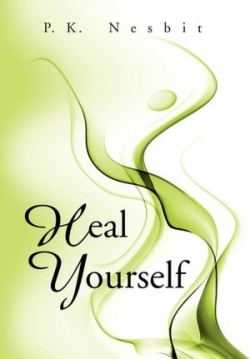Heal Yourself
In Heal Yourself, author P. K. Nesbit attempts to clarify and interpret messages found in the popular text A Course in Miracles.
Written as a study manual, A Course in Miracles was first created by research psychologist Helen Schucman in 1972. According to her, there is no world and there is no death. Reality is singular; each person is responsible for everything he or she sees and does. Schucman, a professor at Columbia University, claimed that Jesus Christ communicated to her the concepts and beliefs of the course. In 1977, New Age guru Marianne Williamson spread its message internationally and the course gained the following of celebrities such as Oprah Winfrey, Shirley MacLaine, and Eckhart Tolle.
Nesbit focuses on how to utilize the concepts of A Course in Miracles in order to heal sickness, conflict, pain, and suffering. According to Schucman, sickness is a decision to attack oneself and illness can only be overcome through love of and oneness with God. The core principle of the course promotes the idea that the world is “all in your head.” Many Buddhists and quantum scholars and scientists like Deepak Chopra, for example, agree. They believe that we are, in fact, thoughts of quantum events in the field of information and energy that have learned how to create the physical machine. Humans are not, as is more commonly believed, physical bodies that have learned how to think.
Christian leaders denounce A Course in Miracles as a cult phenomenon—a course in brainwashing—and a misrepresentation of Christ and the Bible. The key problem is that the course strongly rejects the use of reason and thinking. These leaders also assert that the “Jesus” of the course is a false Jesus, not really the Son of God, who never had a physical body and hence never suffered on the cross. Such tenets conflict with Christian beliefs, and the concern is that Christian followers of the course are likely to be led astray and, thus, compromise their principles.
Nesbit never lets on that the course’s beliefs might be considered incompatible with the Christian faith. He does not digress into polemics. Instead, he sticks to examining the course’s principles and explaining how to use the tools to heal oneself. Throughout the book, Nesbit includes quotations from the course to reinforce the truth of the principle being discussed, though many of the quotes lack citations. Nevertheless, most of the important points are made clearly and ring with spiritual truth: forgiveness and oneness with the Holy Spirit offer the only true solutions to healing.
Grasping the principles of A Course in Miracles requires a quantum leap in thinking. To believe, as Nesbit interprets for readers, that illness is a decision and you will remain sick until you realize you no longer want to remain in conflict, or that conflict is an illusion, are but a few of the difficult ideas the course asks followers to consider. Heal Yourself is a helpful tool for anyone looking to make clearer sense of Schucman’s concepts.
Reviewed by
Gary Klinga
Disclosure: This article is not an endorsement, but a review. The publisher of this book provided free copies of the book and paid a small fee to have their book reviewed by a professional reviewer. Foreword Reviews and Clarion Reviews make no guarantee that the publisher will receive a positive review. Foreword Magazine, Inc. is disclosing this in accordance with the Federal Trade Commission’s 16 CFR, Part 255.

